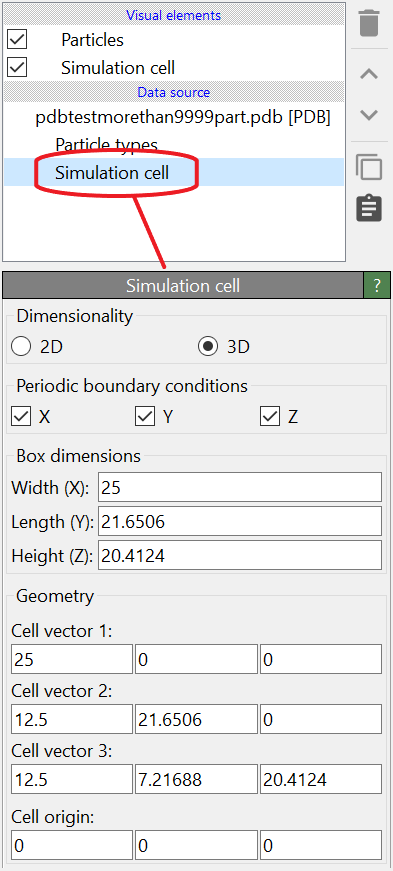Simulation cell

The Simulation cell data object defines the geometry of the simulation domain in two or three dimensions, including boundary conditions (PBC flags). The simulation cell loaded from the imported simulation file can be found in the Data source section of the pipeline editor (see screenshot).
Note: Additionally, the upper section of the pipeline editor shows a second item labeled Simulation cell, which is the corresponding visual element. This visual element controls how the simulation cell appears in rendered images.
If the imported simulation file does not contain any simulation cell information, the corresponding entry will be missing in the pipeline editor and OVITO will assume non-periodic boundary conditions by default. If desired, you can then turn on the option Generate bounding box if needed in the file reader settings to let OVITO automatically generate a simulation cell that tightly encloses all particles in an axis-aligned bounding box.
Dimensionality
OVITO supports both 2D and 3D datasets. The dimensionality is automatically detected during file import but can be manually adjusted in the Simulation cell panel.
In 2D mode, the Z-coordinates of particles and the third simulation cell vector are ignored in most calculations.
Boundary conditions
The periodic boundary condition (PBC) flags determine whether OVITO applies periodicity when performing calculations. Where possible, OVITO reads or infers these flags from the imported simulation file. If needed, you can manually override these flags in the Simulation cell panel.
Note that, even though the PBC flags are labeled as X, Y, and Z, they actually refer to the three vectors spanning the simulation cell, which are not necessarily aligned with the coordinate axes.
Cell geometry
The shape of the simulation cell is defined by three cell vectors \(\bf{a}\), \(\bf{b}\), and \(\bf{c}\) forming a parallelepiped and an origin point, which defines the corner of the cell in the global Cartesian coordinate system, from where the edge vectors originate.
OVITO puts no restrictions on the lengths and angles of the three cell vectors. The only requirement is that they must not be collinear. The vectors can be specified in any order, but the default is to use the following convention: The cell vector \(\bf{a}\) points in the positive X-direction, \(\bf{b}\) in the positive Y-direction, and \(\bf{c}\) in the positive Z-direction.
For informational purposes, the panel also reports the axis-aligned dimensions of the simulation cell (bounding box) as Width (X), Height (Y), and Depth (Z), which are calculated from the three cell vectors. These values are only meaningful for orthogonal cells using the default convention.
Note
The Simulation cell panel, which is found under the Data source section of the pipeline editor, always displays the original cell shape loaded or inferred from the imported simulation file. To modify the simulation cell vectors in OVITO, use the Affine transformation modifier in the data pipeline. The final state of the cell after all applied modifications is shown in the data inspector.
See also
ovito.data.SimulationCell (Python API)